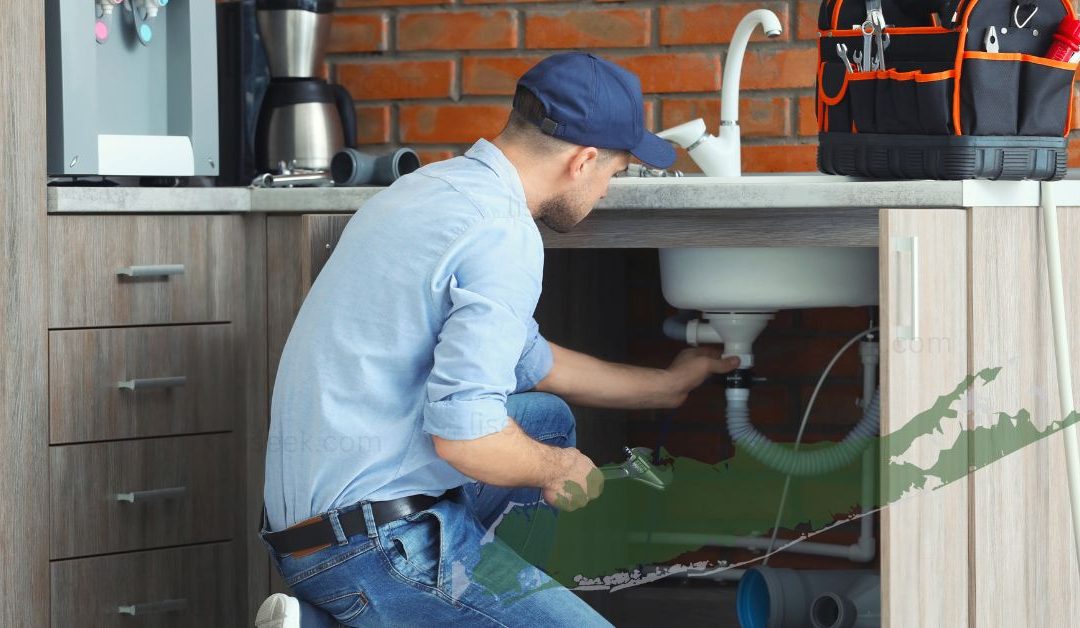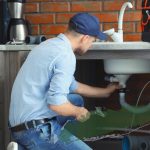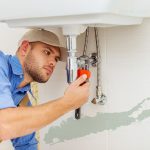If you’re a homeowner in Long Island, New York, chances are you’ve encountered a few plumbing problems along the way. From leaky faucets to clogged drains, these issues can cause headaches and frustration. In this article, we’ll discuss the five most common plumbing issues faced by homeowners in Long Island. Whether you’re looking for solutions or simply want to be prepared, read on to discover how to tackle these common plumbing problems and keep your home running smoothly.
Leaky faucets
Leaky faucets are a common plumbing issue that many homeowners in Long Island encounter. These faucets can be a nuisance and also lead to wasted water and increased water bills if not addressed promptly.
Causes of leaky faucets
There are several reasons why faucets may start to leak. One common cause is worn-out or damaged seals or gaskets inside the faucet. Over time, these seals can deteriorate, resulting in water escaping through small openings. Another possible cause is a loose or worn-out O-ring, which can cause water to seep out around the base of the faucet handle. Corrosion or mineral buildup on internal parts can also lead to leaks.
Potential damage caused by leaky faucets
Although a leaky faucet may seem like a minor issue, it can have several negative consequences if left unaddressed. First and foremost, it wastes a significant amount of water over time, which is not only bad for the environment but also increases your water bill. Additionally, the constant moisture from the leak can promote the growth of mold and mildew, which can be harmful to your health. The dripping sound can also be annoying and disrupt your sleep.
How to fix a leaky faucet
Fixing a leaky faucet may seem like a daunting task, but it is often a simple repair that you can tackle yourself. Before beginning any repairs, make sure to turn off the water supply to the faucet. To fix a leaky faucet, start by identifying the type of faucet you have. There are four main types: compression, cartridge, ball, and ceramic disk faucets. Each type has different repair methods.
For compression faucets, you may need to replace the worn-out rubber washer located at the base of the stem. In cartridge faucets, you can replace the entire cartridge assembly. Ball faucets may require replacing worn-out rubber O-rings or metal ball and springs. Lastly, for ceramic disk faucets, you may need to replace the ceramic disks.
Remember to follow the manufacturer’s instructions and use the appropriate tools for your specific faucet type. If you are unsure or uncomfortable with tackling the repair yourself, it is always best to call a professional plumber who can expertly fix the leaky faucet for you.
Clogged drains
Clogged drains are another prevalent plumbing issue that homeowners in Long Island often encounter. Whether it’s the bathroom sink, kitchen sink, shower, or bathtub, a clogged drain can disrupt your daily routine and cause inconvenience.
Causes of clogged drains
There are several reasons why drains may become clogged. One primary cause is the accumulation of hair, soap scum, and other debris in bathroom drains. In kitchen drains, clogs often occur due to the buildup of grease, food particles, and other materials that get washed down the sink. Tree roots invading the sewer line can also lead to a clogged drain.
Signs of a clogged drain
Recognizing the signs of a clogged drain early on can help prevent further damage. Some common indicators include slow drainage, water backing up in sinks or bathtubs, gurgling sounds coming from drains, and foul odors emanating from the drain. Additionally, if multiple drains in your home are clogged simultaneously, it may indicate a more significant problem with the main sewer line.
How to unclog a drain
Before attempting to unclog a drain, it is important to ensure your safety by wearing gloves and protective eyewear. You can start with simple methods such as using a plunger or a drain snake to dislodge the blockage manually. Plungers are effective for clearing minor clogs, while drain snakes can reach deeper into the pipes.
If a plunger or drain snake doesn’t work, you can try using a mixture of baking soda and vinegar to create a natural drain cleaner. Pour the baking soda down the drain, followed by vinegar. Let it sit for a while, then flush the drain with hot water.
For stubborn clogs that cannot be cleared using DIY methods, it is advisable to contact a professional plumber. They have the necessary tools and expertise to safely and effectively unclog drains without causing further damage to your plumbing system.
Running toilets
Dealing with a running toilet is not only annoying but can also lead to water wastage and higher water bills. A running toilet occurs when water continuously flows into the toilet bowl after flushing, which can be a result of various factors.
Causes of running toilets
One common cause of a running toilet is a faulty flapper valve. The flapper is the rubber mechanism inside the toilet tank that lifts when you flush, allowing water to flow from the tank into the bowl. If the flapper doesn’t seal properly or gets warped or worn out, water can continuously leak into the bowl, causing the toilet to run.
Another reason for a running toilet is a malfunctioning fill valve. The fill valve is responsible for refilling the toilet tank with water after flushing. If the fill valve is not functioning properly, it may not shut off completely, leading to a constant flow of water into the tank.
Effects of running toilets
In addition to the annoyance of constantly hearing water running, a running toilet can waste a significant amount of water. This can lead to higher water bills and is not environmentally friendly. Over time, the continuous flow of water can also cause damage to the toilet’s internal components and potentially result in more serious plumbing issues.
How to fix a running toilet
Fixing a running toilet may require some basic plumbing knowledge, but it is a repair that most homeowners can handle on their own. Start by turning off the water supply to the toilet using the shutoff valve typically located on the wall near the base of the toilet. Remove the toilet tank lid and inspect the flapper valve. If it appears warped or worn out, it is likely the cause of the running toilet and should be replaced.
To replace the flapper valve, turn off the water supply and flush the toilet to drain the tank. Remove the old flapper by detaching it from the chain and replacing it with a new one of the same type and size. Ensure the flapper is properly seated and reattach the chain. Turn the water supply back on and check if the toilet stops running.
If the flapper valve replacement doesn’t resolve the issue, the next step is to check the fill valve. Adjusting or replacing the fill valve may be necessary to stop the continuous flow of water into the tank. If you are unsure or uncomfortable with these repairs, it is always best to consult a professional plumber.
Water heater issues
Water heater problems can be a major inconvenience, especially during the cold winter months. Understanding common water heater issues and their signs can help homeowners in Long Island identify and address problems promptly.
Common water heater problems
One common water heater problem is a lack of hot water. This can be caused by a faulty heating element, a malfunctioning thermostat, or sediment buildup in the tank. Another issue is a leaking water heater, which can result from a damaged or corroded tank, loose fittings, or a faulty pressure relief valve. Additionally, water that smells or tastes strange, such as having a metallic or sulfuric odor, can indicate a problem with the water heater.
Signs of water heater issues
To identify water heater issues, pay attention to signs such as inadequate hot water, fluctuating water temperatures, strange noises coming from the water heater, or rusty-colored water coming from the hot taps. A sudden increase in your energy bills can also indicate reduced efficiency or a problem with your water heater.
Troubleshooting water heater problems
If you are experiencing any water heater issues, it is best to call a professional plumber to thoroughly assess and troubleshoot the problem. However, there are a few things you can check on your own before contacting a professional. Start by checking the circuit breaker or fuse box to ensure that the water heater is receiving power. Inspect the pilot light (for gas water heaters) to see if it is lit and check for any error codes on the unit (for tankless water heaters).
If you notice any leaks, it is important to turn off the power supply and water supply to the water heater immediately to prevent further damage. While some minor issues can be fixed by replacing components such as heating elements or pressure relief valves, more significant problems may require professional repairs or even the replacement of the entire water heater.
Low water pressure
Low water pressure can be frustrating, making simple tasks such as showering or washing dishes a challenging and time-consuming process. Understanding the causes of low water pressure can help homeowners in Long Island find solutions to improve their water flow.
Causes of low water pressure
Several factors can contribute to low water pressure in a household. One common cause is a partially closed or faulty shut-off valve. This valve, usually located near the water meter or individual fixtures, controls the flow of water into the house or specific areas. If it is not fully open or is damaged, it can restrict the water flow, resulting in low pressure.
Another cause of low water pressure is a clogged or corroded pipe. Over time, mineral deposits, rust, or debris can accumulate inside pipes, reducing the diameter and impeding water flow. Additionally, problems with the municipal water supply, such as water main breaks or high demand, can temporarily result in low water pressure in homes.
Effects of low water pressure
Low water pressure can make daily tasks more time-consuming and frustrating. Showering becomes less enjoyable, as water may not rinse off properly and take longer to wash off soap and shampoo. When it comes to household chores such as washing dishes or doing laundry, low water pressure can make them more challenging, requiring more effort and time to complete.
Solutions for low water pressure
To improve low water pressure, start by checking the shut-off valve to ensure it is fully open. If it is partially closed, open it all the way to allow maximum water flow. Then if the valve appears to be damaged, it may need to be replaced by a professional plumber.
If the shut-off valve is not the issue, the next step is to inspect your pipes for any signs of clogs or corrosion. While some minor clogs can be cleared using DIY methods such as a plunger or drain snake, more severe blockages may require professional assistance. Plumbers can use specialized tools and techniques to remove the buildup and restore normal water flow.
In cases where the low water pressure is due to municipal supply issues, it is best to contact the water company to inquire about the situation and potential solutions. They may be able to provide information on any ongoing work or suggest alternatives to address the low water pressure.
Frozen pipes
Frozen pipes are a common concern for homeowners in Long Island, especially during the winter months when temperatures drop significantly. Understanding the causes, signs, and preventive measures can help protect your plumbing system from the potential damage caused by frozen pipes.
Causes of Frozen Pipes
Frozen pipes occur when the water inside the pipes freezes due to exposure to extremely cold temperatures. Poor insulation or inadequate heating can make pipes more susceptible to freezing. Pipes located in unheated areas, such as exterior walls, basements, attics, or crawl spaces, are particularly vulnerable. During freezing conditions, exposed pipes can reach freezing temperatures, causing the water inside to freeze and expand, leading to pipe bursts.
Signs of Frozen Pipes
Recognizing the signs of frozen pipes can help you take immediate action and prevent pipe bursts. One common sign is reduced or no water flow from faucets or fixtures. If you turn on a faucet and only a trickle of water comes out or no water flows at all, it may indicate a frozen pipe. Additionally, frost or ice buildup on visible pipes, such as those under sinks or in basements, is another sign of potential freezing.
How to prevent and thaw frozen pipes
Preventing frozen pipes is essential to avoid costly repairs and water damage. Proper insulation is key to protecting pipes from freezing. Insulate any exposed pipes with foam sleeves or special pipe insulation, paying particular attention to pipes in unheated areas. Seal any gaps or cracks in exterior walls to minimize cold air infiltration.
During extremely cold weather, it is advisable to keep your thermostat set to a consistent temperature, even when you are away from home. Allowing faucets to drip slightly can also help prevent pipes from freezing, as moving water is less likely to freeze.
If you suspect a frozen pipe, it is crucial to act quickly to prevent pipe bursts. Start by turning off the water supply to the affected area to minimize potential damage. You can then try to thaw the pipe using a hair dryer, heating pad, or space heater. Start from the end nearest to the faucet and work your way backward. Never use an open flame or propane torch to thaw pipes, as it can be a fire hazard.
If you cannot locate the frozen area or are unable to thaw the pipe, it is best to call a professional plumber who can safely and effectively address the issue.
Sewer line backups
Dealing with a sewer line backup is a messy and unpleasant situation that no homeowner wants to experience. Understanding the common causes, signs, and necessary steps can help homeowners in Long Island effectively address sewer line backups.
Common causes of sewer line backups
Several factors can contribute to sewer line backups. One common cause is the accumulation of debris, grease, and other materials in the sewer line over time. This gradually restricts the flow of wastewater and can eventually lead to a complete blockage. Tree roots invading the sewer line can also cause backups, as the roots grow into the line and block the flow.
Another possible cause is a collapsed or damaged sewer pipe. Aging pipes or pipes made from inferior materials can deteriorate and fail, resulting in backups. It is also possible for sewer lines to become clogged due to non-flushable items, such as feminine hygiene products or wipes, being flushed down the toilet.
Signs of a Sewer Line Backup
Recognizing the signs of a sewer line backup is crucial to take immediate action and prevent further damage. Some common indicators include multiple drains in the home draining slowly or not at all, gurgling sounds coming from drains or toilets, foul odors coming from drains or the yard, and sewage backups in toilets, bathtubs, or sinks. If you notice any of these signs, it is essential to address the issue promptly.
How to deal with a sewer line backup
Dealing with a sewer line backup requires the expertise of a professional plumber. They have the necessary equipment and knowledge to assess the situation, locate the blockage, and safely remove it. Attempting to handle a sewer line backup yourself can be hazardous and cause further damage to the plumbing system.
If you suspect a sewer line backup, it is crucial to turn off the water supply to the affected area and avoid using any plumbing fixtures until the issue has been resolved. Contact a licensed plumber who can conduct a thorough inspection, identify the cause of the backup, and recommend the most appropriate solution, which may include drain cleaning, hydrojetting, or even repair or replacement of the sewer line.
Sump pump failures
Sump pump failures can be a major concern, particularly for homeowners in Long Island who experience heavy rainfall or have basements prone to flooding. Understanding the reasons for sump pump failures, recognizing the signs, and taking appropriate steps can help prevent severe water damage and protect your home.
Reasons for sump pump failures
Sump pump failures can occur due to various reasons. One common cause is a power outage or electrical failure. If the sump pump is not equipped with a backup power source or the power is not restored quickly, it may fail to operate during a storm or flood. Mechanical failures, such as a stuck or broken float switch or a malfunctioning motor, can also cause sump pump failures. Additionally, improper installation or maintenance can affect the pump’s performance.
Signs of a failing sump pump
Recognizing the signs of a failing sump pump is essential to address any issues before they lead to water damage. Some common indicators include unusual noises coming from the sump pump, frequent cycling on and off, failure to turn on during heavy rainfall, and visible signs of rust or corrosion on the pump unit. If you notice any of these signs, it is recommended to have your sump pump inspected and serviced.
Steps to fix a sump pump issue
If you suspect a problem with your sump pump, there are a few steps you can take to troubleshoot the issue. Firstly, check the power supply to ensure it is functioning properly. If there is a power outage, consider installing a battery backup system or a generator to ensure continuous operation during storms or power failures.
Inspect the pump’s float switch to ensure it moves freely and is not obstructed by debris. Clean any dirt or debris from the sump pit and check the discharge pipe for clogs or obstructions. If you are unsure or uncomfortable with these troubleshooting steps, it is best to contact a professional plumber who specializes in sump pump repairs. They can thoroughly inspect the pump, identify the cause of the failure, and perform any necessary repairs or replacements.
Burst pipes
Burst pipes are a major plumbing emergency that can cause extensive water damage and costly repairs. Understanding the causes, signs, and necessary actions to take can help homeowners in Long Island minimize the impact of burst pipes and protect their property.
Causes of burst pipes
Burst pipes most commonly occur during freezing weather when water inside the pipes freezes and expands, causing the pipe to crack or rupture. However, burst pipes can also be caused by other factors such as excessive water pressure, aging pipes that have deteriorated over time, or physical damage to the pipes from construction or accidental impacts.
Signs of burst pipes
Recognizing the signs of burst pipes is crucial to respond quickly and minimize further damage. Some common indicators include a sudden loss of water pressure, water discoloration or rust in the water, wet spots or water stains on walls, ceilings, or floors, unusual sounds of running water behind walls, or visible bulging or deformation of pipes. If you notice any of these signs, it is essential to take immediate action.
Actions to take when dealing with burst pipes
If you suspect a burst pipe, it is important to act quickly to minimize water damage. Start by turning off the main water supply to your home to prevent further water flow. Next, open all faucets to drain the remaining water from the pipes. It is also advisable to turn off the electricity supply to any affected areas to avoid electrical hazards.
Contact a licensed plumber as soon as possible to assess the situation and make the necessary repairs. Burst pipes require professional attention, as they may involve cutting out damaged sections and replacing them with new pipes. While waiting for the plumber to arrive, you can place buckets or towels around the affected area to catch any leaking water and minimize damage to your property.
Toilet bowl cracks
Toilet bowl cracks are a serious plumbing issue that can lead to leaks and water damage and ultimately require the replacement of the entire toilet. Understanding the causes, risks, and appropriate actions can help homeowners in Long Island address toilet bowl cracks promptly.
Causes of toilet bowl cracks
Toilet bowl cracks can occur due to various reasons. One common cause is physical impact or stress placed on the bowl, such as dropping a heavy object onto it or sitting on the bowl lid. Temperature fluctuations, especially when exposed to extremely cold or hot temperatures, can also cause cracks. Additionally, aging toilets made from inferior materials or with manufacturing defects can develop cracks over time.
Risks associated with toilet bowl cracks
Toilet bowl cracks pose several risks, including water leaks that can lead to water damage in your bathroom. Even small cracks can cause constant slow leaks, wasting water and potentially causing mold or mildew growth. Larger cracks can result in significant leaks, flooding, and damage to the bathroom floor and surrounding areas.
Another risk is the potential for injury. Cracked toilet bowls can be sharp and jagged, posing a risk of cuts or other injuries if someone sits on the cracked section. It is crucial to address toilet bowl cracks promptly to avoid these risks.
How to address toilet bowl cracks
If you discover a crack in your toilet bowl, it is important to take immediate action. Start by turning off the water supply to the toilet to prevent any further leaks. Empty the bowl and tank by flushing the toilet repeatedly until the water level is low. Avoid using the toilet until the crack is repaired or the toilet is replaced.
Next, assess the severity of the crack. If it is a hairline crack or a small cosmetic crack that does not extend through the entire bowl, you may be able to temporarily seal it using epoxy or porcelain repair kits available in hardware stores. However, it is important to note that these repairs are not permanent and may not be sufficient for long-term reliability.
For larger cracks or cracks that extend through the entire bowl, it is recommended to replace the toilet entirely. Contact a professional plumber to safely remove the cracked toilet bowl and install a new one. They can also assess if any underlying issues, such as improper installation or manufacturing defects, contributed to the crack and make appropriate recommendations to prevent future problems.
In conclusion, being aware of the most common plumbing issues in Long Island homes can help homeowners be prepared and take appropriate action when faced with these challenges. Whether it’s a leaky faucet, clogged drain, running toilet, water heater issue, low water pressure, frozen pipes, sewer line backup, sump pump failure, burst pipes, or toilet bowl cracks, understanding the causes, signs, and solutions for each problem can save you time, money, and unnecessary stress. While some minor repairs can be tackled by homeowners themselves, it is always wise to contact a professional plumber for more complex or extensive plumbing issues to ensure proper and long-lasting solutions. Remember, regular maintenance and prompt repairs are key to maintaining a healthy and functional plumbing system in your Long Island home.
© 2024 by LISeekcom. All rights reserved. No part of this document may be reproduced or transmitted in any form or by any means, electronic, mechanical, photocopying, recording, or otherwise, without prior written permission of LISeekcom.






